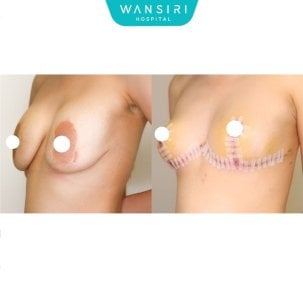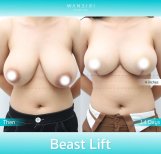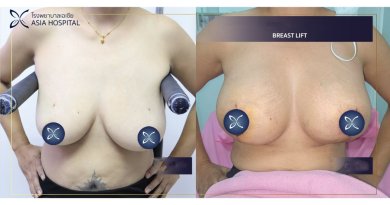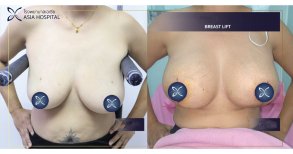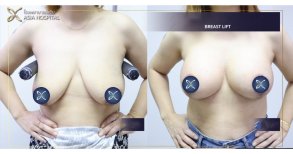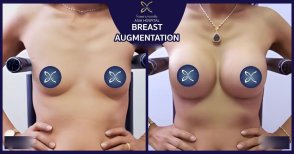- Técnica: Técnica moderna de elevação mamária "donut"
- Giraron Meevassan concluiu seu aperfeiçoamento em cirurgia plástica na Universidade ASAN e na Universidade Chulalongkorn.
- O Hospital Wansiri demonstra 99,0% de sucesso em cirurgias plásticas complexas, o que comprova o alto nível de atendimento.
- Inclui: estacionamento, serviços de enfermagem 24 horas, três refeições diárias preparadas por nutricionista, área de café, cuidados pós-operatórios, conjunto para curativos de feridas, medicamentos pós-operatórios, serviços de tradutor, pensão completa (café da manhã, almoço, jantar, bebidas), hospitalização, transfer para a clínica
- Informações sobre a estadia: 1 dia de permanência no hospital incluído, hospedagem em hotel não incluída.
Como funciona
Qual é o Custo de Lifting mamário em Tailândia? Descubra Agora
O custo de uma mastopexia na Tailândia normalmente varia de $4,400 a $5,300. Os preços podem variar com base na clínica, na experiência do cirurgião, na extensão da elevação (com ou sem implantes) e na técnica cirúrgica utilizada. Nos Estados Unidos, o preço médio é de $12,800 (por ASPS). Isso significa que uma mastopexia na Tailândia é cerca de 62% mais barata do que nos EUA.
As clínicas tailandesas geralmente incluem exames pré-operatórios, anestesia geral, a própria cirurgia de elevação mamária, 1 a 2 noites no hospital, medicações e consultas de acompanhamento. Nos EUA, o preço listado frequentemente cobre apenas a taxa do cirurgião, sendo que a anestesia, o uso das instalações e os cuidados pós-operatórios são cobrados separadamente. Sempre confirme o que está incluído no pacote na clínica escolhida.
Principais benefícios
- Experimente um lifting de mama na Tailândia com 60-75% menos do que nos EUA e na Austrália.
- As opções disponíveis incluem o lifting vertical, o lifting periareolar e a técnica de lifting âncora.
- Avaliação fotográfica gratuita por um especialista para selecionar a clínica ideal e o método de lifting adaptado às suas necessidades.
- Garantia de 100% de proteção de dados e confidencialidade.
- Acesse ofertas exclusivas de clínicas renomadas tailandesas de $4,391.
Revisado por
Fahad MawloodNão perca ofertas exclusivas de Lifting mamário em Tailândia para dezembro 2025
- Técnica: elevação padrão dos seios sem o uso de implantes
- Akkrasash Vondjirad é uma filial do Asia Cosmetic Hospital e oferece assistência especializada na área de cirurgia plástica.
- O Asia Cosmetic Hospital possui a prestigiada acreditação da Joint Commission International (JCI), garantindo os mais altos padrões de atendimento ao paciente.
- Incluído no preço: consulta por vídeo ou texto, consulta médica, anestesia geral, testes pré-operatórios, exames de sangue, medicamentos, consulta de seguimento, medicamentos pós-operatórios, radiografia panorâmica dentária, ultrassom, serviços de tradução, consulta com cirurgião, visita de seguimento, consulta com cardiologista, consulta com cirurgião plástico, pensão completa (café da manhã, almoço, jantar, bebidas), hospitalização, translado para o hospital.
- Informação sobre estadia: 2 dias de estadia no hospital, 7 dias de estadia no hotel, incluído no preço.
Descubra as Melhores Clínicas de Lifting mamário em Tailândia: 5 opções Verificadas e Preços
ID Clinic Bangkok
Dr Phatcharasak Kraisornphongsakul Md
DGB Clinic
Metha Chitthichanont
B.Care Medical Center
Lifting mamário em Tailândia: um cronograma dia a dia
Dia 1: Chegada à Tailândia
- Ao chegar, você deve garantir que possui todos os documentos necessários, incluindo passaporte, visto e quaisquer registros médicos solicitados pela clínica.
- Organize o transporte do aeroporto para a sua acomodação. Confirme se o seu pacote inclui serviços de transferência VIP da clínica.
- Faça o check-in no seu hotel. Reserve o dia para descansar e se adaptar ao fuso horário.
- Mantenha-se hidratado e evite álcool para preparar o seu corpo para o procedimento que se aproxima.
Dia 2: Consulta Pré-Cirúrgica e Avaliação
- Você precisa comparecer à consulta agendada com a equipe cirúrgica. Esta é uma oportunidade para discutir suas preocupações e expectativas.
- Submeta-se a uma avaliação pré-operatória abrangente, incluindo exame físico, exames de sangue e quaisquer imagens necessárias, como escaneamento facial 3D ou tomografia computadorizada, se exigido.
- Discuta as técnicas específicas de lifting de mama recomendadas para você, como a cirurgia de lifting mamário em forma de T ou em rosquinha.
- Revise os detalhes do procedimento, incluindo anestesia, duração da cirurgia e expectativas de recuperação.
- Confirme o uso de implantes específicos, como o gel Mentor Xtar ou Motiva Ergonomix, se aplicável.
- Certifique-se de que todas as suas perguntas sejam respondidas. Compreenda as instruções pré-cirúrgicas, incluindo restrições alimentares e ajustes de medicação.
Dia 3: Dia da Cirurgia
- Faça jejum conforme instruído, geralmente a partir da meia-noite anterior ao dia da cirurgia.
- Chegue à clínica ou hospital no horário designado para o seu procedimento de lifting de mama.
- Encontre-se com o anestesista para discutir o processo de anestesia geral.
- Submeta-se à cirurgia de lifting de mama, que pode envolver técnicas como a técnica de cicatriz em âncora ou o uso de implantes de silicone de superfície sedosa Motiva.
- Após a cirurgia, você será monitorado na sala de recuperação até estar estável.
- Passe a noite no hospital sob cuidados de enfermagem VIP, conforme incluído no seu pacote.
Dia 4: Cuidados Pós-Operatórios Imediatos
- Receba cuidados pós-operatórios, incluindo curativos e controle da dor.
- Consulte-se com o seu cirurgião para discutir o resultado da cirurgia e receber instruções personalizadas pós-operatórias.
- Certifique-se de ter todos os medicamentos para levar para casa e de entender o cronograma para tomá-los.
- Organize o transporte de volta à sua acomodação caso não seja providenciado pela clínica.
- Descanse e evite atividades cansativas. Siga as recomendações alimentares para auxiliar a recuperação.
Dia 5-7: Fase Inicial de Recuperação
- Compareça às consultas de acompanhamento conforme agendado para monitorar o progresso da sua recuperação.
- Continue com os cuidados com o ferimento e tome os medicamentos conforme prescrito.
- Engaje-se em atividades leves, evitando qualquer levantamento de peso ou exercício vigoroso.
- Entre em contato com a clínica se experimentar qualquer sintoma incomum, como inchaço excessivo ou dor.
- Maintenha uma dieta saudável e esteja hidratado para apoiar o processo de cura do seu corpo.
Semana 2: Continuação da Recuperação e Verificação Final
- Retorne à clínica para uma verificação pós-operatória final. Isso pode incluir a remoção de pontos, se necessário.
- Discuta quaisquer preocupações ou perguntas com o seu prestador de cuidados de saúde.
- Receba liberação para retomar atividades mais normais, com base no seu progresso de cicatrização.
- Continua a evitar fumar e consumir álcool, pois isso pode prejudicar a recuperação.
- Agende quaisquer consultas de acompanhamento adicionais, se recomendado pelo seu cirurgião.
Semana 3: Preparação para Partida
- Certifique-se de que toda a documentação médica está em ordem, incluindo um resumo do seu procedimento e status de recuperação.
- Confirme os seus arranjos de viagem para o retorno, garantindo que tenha suporte adequado para a jornada.
- Embale quaisquer medicamentos ou suprimentos restantes necessários para a continuação da recuperação.
- Entre em contato com a clínica para quaisquer perguntas ou preocupações de última hora antes da partida.
Semana 4: Retorno para Casa
- Viaje de volta para casa, seguindo quaisquer instruções específicas fornecidas pela sua equipe de saúde para a jornada.
- Continue com a rotina de cuidados pós-operatórios prescrita, incluindo cuidados com o ferimento e medicação.
- Agende uma consulta de acompanhamento com o seu
A Bookimed, uma plataforma líder global em turismo médico, está comprometida em ajudar clientes que procuram levantamento de seios na Tailândia, oferecendo assistência especializada e soluções médicas confiáveis para cada situação. O sistema de ranking automático inteligente é usado para compor listagens transparentes de clínicas, meticulosamente mantidas por um cientista de dados usando IA para precisão. A plataforma garante autenticidade ao publicar avaliações de pacientes reais após seus tratamentos. A Bookimed oferece soluções médicas abrangentes, com atualizações de clínicas para garantir confiabilidade. O conteúdo sobre levantamento de seios na Tailândia, elaborado por autores médicos experientes e revisado por especialistas, adere às Diretrizes Editorias da Bookimed, refletindo o compromisso da plataforma em fornecer informações de saúde de alta qualidade e claras. Para mais detalhes ou dúvidas, sinta-se à vontade para nos contatar em marketing@bookimed.com ou saber mais sobre nós e nossa missão aqui.
Obtenha uma Avaliação Médica para Lifting mamário em Tailândia: Consulte com 34 médicos Experientes Agora
Ver todos os médicosMetha Chitthichanont
Dr Kotchakorn Stitstein
Ploypailin Rattanachinnakorn
Pichet Rodchareon Md
Histórias em vídeo de pacientes da Bookimed
Avaliações sobre Bookimed: descubra percepções de pacientes
Todas as avaliaçõesLifting mamário: Fotos antes & depois
Ver todos Antes&DepoisCompartilhar este conteúdo
FAQ sobre Lifting mamário em Tailândia
A Tailândia é um bom lugar para realizar o procedimento de lifting das mamas?
De acordo com Bookimed, a Tailândia é uma excelente escolha para cirurgia de levantamento de seios devido à alta qualidade dos serviços médicos oferecidos por suas inúmeras clínicas.
- O Bumrungrad International Hospital é um dos maiores centros privados do Sudeste Asiático, atendendo mais de 1 milhão de pacientes anualmente, metade dos quais são internacionais, provenientes de mais de 190 países. É reconhecido como um dos 10 melhores hospitais e entre as 30 clínicas tecnologicamente mais avançadas do mundo.
- O B.Care Medical Center é outra clínica renomada, especializada em correções mamárias, rinoplastia, abdominoplastia, lifting facial e outras cirurgias plásticas. Atende cerca de 70 pacientes internacionais anualmente, a maioria dos Estados Unidos, Austrália, Europa e Sudeste Asiático.
- A Nirunda e a Bellamode Clinic também são conhecidas instalações médicas em Bangkok, Tailândia, com pacientes dos Estados Unidos, Canadá, Reino Unido e outros países que as escolhem para cuidados de saúde.
- O Yanhee Hospital é outro hospital popular em Bangkok, com Obstetrícia e Ginecologia, Cirurgia Plástica e Medicina Estética e Cosmetologia como suas especialidades mais fortes.
Baseado em avaliações de pacientes, as equipes médicas são profissionais, competentes e amigáveis, enquanto os hospitais são elogiados por sua limpeza, conforto e eficiência. Pacientes dos Estados Unidos, Austrália, Europa e Sudeste Asiático são a maioria dos que viajam para a Tailândia para levantamento de seios. Os médicos têm ampla experiência na realização de cirurgias de levantamento de seios, com uma alta taxa de sucesso.
No geral, a Tailândia é um ótimo lugar para cirurgia de levantamento de seios, com suas numerosas clínicas especializadas, médicos experientes e serviços médicos de alta qualidade.
Quanto tempo leva para fazer uma mastopexia na Tailândia?
Qual é o melhor hospital para Mastopexia na Tailândia?
A classificação do Bookimed revelou os 5 melhores hospitais na Tailândia para Mastopexia:
- Hospital Internacional Bumrungrad
- B.Care Medical Center
- Nirunda
- Clínica Bellamode
- Hospital Yanhee
Quem são os melhores médicos de mastopexia na Tailândia?
A Bookimed identificou os melhores médicos na Tailândia que se destacam em realizar a mastopexia:
- Anuchit Kitsombat, Medicina Estética e Cosmetologia, Cirurgia Plástica, 23 anos de experiência
- Siripong Prasertsuntarasai, Medicina Estética e Cosmetologia, Cirurgia Plástica, 15 anos de experiência
- Amorn Poomee, Medicina Estética e Cosmetologia, com pontuação de 5,0 nas avaliações
- Ajchariya Sarovath, Medicina Estética e Cosmetologia
- Akkavich Harnnavachok, Medicina Estética e Cosmetologia, 12 anos de experiência
Qual é a diferença entre elevação mamária e elevação mamária com aumento?
Um lifting de mama (mastopexia) remodela e levanta seios caídos removendo o excesso de pele e apertando o tecido, mas não aumenta o tamanho dos seios. O lifting de mama com aumento combina este procedimento de elevação com implantes para adicionar volume e plenitude. A Sociedade Americana de Cirurgiões Plásticos explica que um lifting de mama sozinho oferece um contorno mais natural, enquanto o aumento de mama proporciona uma aparência mais cheia e arredondada.
Como saber se sou uma boa candidata para a cirurgia de lifting de mamas?
Você pode ser uma boa candidata se tiver seios caídos, mamilos que apontam para baixo ou pele esticada devido ao envelhecimento, gravidez ou perda de peso. As candidatas devem estar em boa saúde, com peso estável e não estar amamentando atualmente.
Qual é o tempo típico de recuperação após a cirurgia de mama?
A maioria dos pacientes retorna ao trabalho em 7–10 dias. O inchaço e os hematomas melhoram gradualmente ao longo de 2–4 semanas, com os resultados completos visíveis após 3–6 meses. Os cirurgiões frequentemente recomendam o uso de um sutiã de suporte por pelo menos 6 semanas após a cirurgia.
Quanto tempo os resultados de um lifting de seios geralmente duram?
Os resultados normalmente duram de 10 a 15 anos, mas a longevidade depende de fatores como qualidade da pele, idade, estabilidade de peso e estilo de vida. Mudanças significativas de peso ou gestações após a cirurgia podem afetar os resultados.
Haverá cicatrizes visíveis após a cirurgia de lifting de seios?
Esperam-se cicatrizes, mas são colocadas ao longo dos contornos naturais dos seios e desvanecem-se ao longo de 12–18 meses. Técnicas como a incisão vertical ou em "pirulito" reduzem a visibilidade. Seguir os conselhos do seu cirurgião sobre cuidados com a ferida e usar gel de silicone pode ajudar a melhorar a aparência das cicatrizes.
É possível combinar uma mastopexia com outros procedimentos, como colocação de implantes ou redução mamária?
Sim, a cirurgia de levantamento e aumento dos seios são frequentemente combinadas para adicionar volume. Combinar um levantamento de seios com redução pode diminuir o tamanho e levantar simultaneamente. Seu cirurgião recomendará a melhor combinação com base em seus objetivos.
Quais são os riscos ou complicações potenciais associados à cirurgia de levantamento de mama?
As complicações da mastopexia são raras, mas podem incluir infecção, cicatrizes, alterações na sensibilidade do mamilo e assimetria. Cerca de 87% dos pacientes não apresentam complicações após a cirurgia de levantamento e aumento das mamas, de acordo com um estudo publicado na revista Plastic and Reconstructive Surgery.
É seguro realizar uma cirurgia de elevação das mamas na Tailândia?
Sim, é seguro quando realizado em clínicas credenciadas por cirurgiões certificados. Procure provedores certificados pela Sociedade Tailandesa de Cirurgiões Plásticos e Reconstrutivos ou internacionalmente pela ISAPS. Os cirurgiões tailandeses frequentemente são treinados no exterior e seguem protocolos de segurança globais.
Vou poder amamentar após fazer uma mastopexia?
Amamentar após uma mastopexia é possível, mas não garantido. Depende da técnica cirúrgica e se os ductos lactíferos e nervos foram preservados. De acordo com o CDC, algumas mulheres podem produzir leite após a cirurgia mamária, mas podem precisar suplementar.
Quais são as principais clínicas na Tailândia para cirurgia de levantamento de mama?
Com base no ranking do Bookimed, as principais clínicas são:
- Hospital Wansiri – Bangkok, Tailândia
- Bangkok Plastic Surgery – Bangkok, Tailândia
- ID Clinic Bangkok – Bangkok, Tailândia
- Hospital Internacional Yanhee – Bangkok, Tailândia
- Clínica Rattinan – Bangkok, Tailândia
- Hospital Cosmético da Ásia – Bangkok, Tailândia
- Centro Internacional de Cirurgia do Hospital Dr. Chen – Bangkok, Tailândia
O que você deve saber sobre a Tailândia antes da viagem?
Nome oficial | O Reino da Tailândia |
Moeda | Baht Tailandês (você também pode pagar por serviços em dólares) |
Melhor período para a viagem | Novembro-início de abril |
Idioma | Tailandês (a maioria dos funcionários médicos fala inglês fluentemente) |
Visto | é necessário para uma viagem de 3-6 meses |
Diferença de horário com a Europa | 7 horas |
Diferença de horário com os EUA | 12 horas |
Capital | Bangkok |
Centro de turismo médico | Bangkok |
Resorts populares | Koh Samui, Phuket, Chiang Mai, Koh Chang, Hua Hin |
Qual é o nível da medicina na Tailândia?
A saúde é o setor de desenvolvimento chave do governo tailandês. As autoridades tailandesas estão convencidas de que o cuidado com a saúde dos cidadãos deve ser uma prioridade absoluta da política estatal e gastam cerca de 25 bilhões de baht anualmente em saúde.
Como resultado, 36.673 instalações médicas prestam excelente atendimento médico no país. 64 centros no Reino possuem certificação da JCI (Joint Commission International), o aprimorador internacional da qualidade e segurança da saúde em todo o mundo. O índice de certificados obtidos é o maior. Para comparação, Israel possui 20 instalações acreditadas pela JCI e a Alemanha — apenas 10 clínicas deste tipo.
Que serviço de hotel é oferecido aqui?
No Reino da Tailândia, hotéis de diferentes faixas de preço e níveis de serviço são apresentados. O nível dos hotéis tailandeses é comparável aos hotéis da Tunísia, Marrocos ou Egito. A maioria dos turistas escolhe hotéis de 4 e 5 estrelas com refeições all-inclusive. Esses hotéis oferecem tudo para uma estadia confortável: comida variada, um grande território bem cuidado, animação para crianças e adultos. Alguns hotéis têm seu próprio parque aquático, que os hóspedes podem usar gratuitamente. Viajantes com orçamento limitado podem reservar um hotel econômico de 3 estrelas com meia pensão ou sem refeições.
Qual é a melhor época para viajar para a Tailândia?
A principal vantagem dos resorts tailandeses é a longa temporada de praia. Na costa leste e na costa oeste, as características climáticas são diferentes, então leve isso em consideração ao planejar a viagem. A melhor época para viajar é durante a estação fresca e seca, entre novembro e início de abril. Um grande influxo de turistas ocorre de março a maio, quando a temperatura do ar é de +30°C.
Preciso de visto?
Por enquanto, o Reino da Tailândia exige diferentes regimes de visto para diversos estados. Alguns estrangeiros podem permanecer no país por 60 dias sem controle de visto, enquanto outros — apenas 14 dias.
Quanto tempo você pode ficar na Tailândia e quais países podem cruzar a fronteira facilmente leia aqui.
Quais documentos são necessários para solicitar um visto para a Tailândia para tratamento?
Os vistos para viagens à Tailândia exigem uma série de documentos. Os documentos necessários podem ser submetidos 90 dias antes da partida planejada. A lista de documentos inclui:
- Cartão de identificação
- confirmação da inscrição online e preenchimento do questionário
- certificado de renda e disponibilidade de fundos (20.000 baht por pessoa/40.000 baht por família)
- apólice de seguro para estadia na Tailândia (original e cópia)
- 2 fotos (4x6)
- comprovante de visto
- reserva de bilhete aéreo de ida e volta (pago integralmente) e hotel
- opinião médica sobre a necessidade de tratamento.

